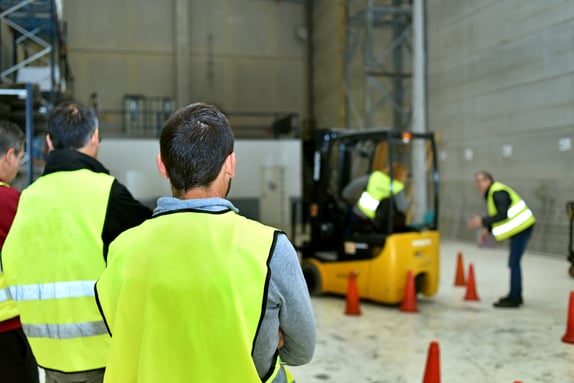In today’s competitive business landscape, prioritizing safety is no longer optional. It’s a fundamental responsibility for any organization that values its employees and aims for long-term success. Accidents and injuries not only cause immense personal suffering, but they also lead to lost productivity, increased costs, and a potential tarnish on your company’s reputation.
The key to fostering a safe work environment lies in proactive measures, and effective safety training plays a critical role in this equation. It’s more than just a mandatory box to check during onboarding. It’s about empowering your workforce with the knowledge, skills, and confidence they need to identify and mitigate hazards, prioritize their well-being, and ultimately, prevent accidents. But how do you design safety training that’s both informative and engaging? How do you ensure it truly resonates with employees and translates into safe work practices?
This comprehensive guide will equip you with the essential steps to create impactful safety training and workshops. By following these strategies, you can transform safety training from a dull obligation into an engaging and empowering experience for your employees, ultimately leading to a safer and more productive work environment for everyone.
1. Identify and Address Your Specific Needs
Conduct a Job Safety Analysis (JSA): This involves a team effort to investigate work areas and identify potential hazards associated with each job and operation. The JSA should not just identify hazards but also prioritize them using the hierarchy of controls. This prioritization framework emphasizes eliminating hazards entirely as the best course of action, followed by substitution, engineering controls, work practice controls, and finally, personal protective equipment (PPE) as the last resort. By understanding your specific hazards, you can tailor your training to address the most pressing risks employees face.
2. Tailor Your Approach to Your Audience
- Consider Learning Styles: People learn in different ways. Some may prefer lectures and written materials, while others thrive with hands-on activities, discussions, or visual aids. Vary your training methods to cater to different learning styles.
- Match Experience Level: For new employees, focus on foundational safety principles and procedures. For experienced workers, delve deeper into complex topics and best practices.
3. Set Clear Learning Objectives
SMART Goals: When defining your goals, follow the SMART framework. This means your goals should be Specific, Measurable, Achievable, Relevant, and Time-bound. For example, instead of a vague goal of “improving fire safety awareness,” a SMART goal could be “By the end of the training, 90% of participants will be able to demonstrate the proper use of a fire extinguisher within 30 seconds.”
4. Make it Interactive and Engaging
Go Beyond Lectures: While lectures can be informative, they can also be passive and forgettable. Incorporate activities that encourage participation. This could involve:
- Group discussions: Pose questions and facilitate discussions about safety procedures and best practices.
- Case studies: Present real-world scenarios where safety protocols were either followed or breached and discuss the consequences.
- Polls and quizzes: Use online tools or simple hand signals to gauge understanding and keep participants engaged.
- Simulations: When applicable, create simulated scenarios where trainees can practice safety procedures in a controlled environment.
5. Emphasize the “Why” Behind Safety
Don’t just tell employees what to do, explain the “why.” Help them understand the potential consequences of unsafe behavior. This could involve:
- Discussing past accidents or near misses that have occurred in the workplace.
- Sharing statistics on workplace injuries and their impact on individuals, families, and the company.
- Explaining the legal implications of safety violations.
By understanding the “why,” employees are more likely to internalize safety principles and take ownership of their well-being.
6. Get Employees Involved
- Solicit Feedback During Development: Involve employees in the development of your training program. This could involve focus groups or surveys to understand their concerns and preferred learning methods.
- Employee Participation in Training: Consider incorporating employee expertise into the training itself. Employees can lead discussions on specific safety topics they’re familiar with or demonstrate safety procedures they use regularly.
7. Use Multimedia Elements
Visuals are powerful learning tools. Instead of relying solely on text-heavy presentations, incorporate multimedia elements such as:
- Images and infographics: Use clear and concise visuals to represent safety procedures and hazards.
- Safety videos: Short, informative videos can demonstrate proper safety techniques and real-world consequences of unsafe practices.
- Animations: Animations can be particularly helpful for explaining complex procedures or machinery.
8. Practice Makes Perfect
Hands-on Practice: When applicable, incorporate workshops or skills sessions into your training. This allows trainees to:
- Practice using safety equipment like fire extinguishers or respirators.
- Rehearse emergency evacuation procedures.
- Demonstrate proper lifting techniques to prevent injuries.
Hands-on practice helps build muscle memory and confidence in applying safety procedures in real-world situations.

9. Make It Memorable
Reinforcement is Key: Ensure your safety training will stick in the minds of employees by using high-visibility positive reinforcement techniques:
- Safety campaigns: Launch campaigns with posters, slogans, or contests to keep safety awareness high.
- Near miss reporting programs: Encourage employees to report near misses so that potential hazards can be addressed before an accident occurs.
- Safety recognition programs: Recognize employees who consistently demonstrate safe work practices or who report safety hazards.
By implementing these strategies, you can create a culture of safety where safe behavior is not just encouraged, but actively promoted and rewarded.
10. Continuously Evaluate and Improve
By continuously evaluating and improving your safety training program, you can ensure it remains effective in keeping your workplace safe for everyone. To support these goals, be sure to:
- Gather Feedback: Don’t assume your training is effective just because it’s delivered. Gather feedback from participants through surveys, focus groups, or anonymous polls. Ask them about the clarity of the content, the effectiveness of the delivery methods, and their overall takeaways.
- Analyze Training Data: If applicable, track safety metrics such as incident rates, near misses, and employee participation in safety programs. These metrics can help you assess the impact of your training and identify areas for improvement.
- Review and Update: Based on the feedback and data you gather, review and update your training materials and delivery methods regularly. This ensures your training stays relevant, addresses current hazards, and incorporates best practices in adult learning.

The Last Word on Safety Training
Effective safety training isn’t just about ticking a compliance box; it’s about investing in the well-being of your employees and fostering a culture of safety within your organization. By following the steps outlined above, you can create engaging and informative training programs that empower employees to prioritize safety in their daily work lives.
However, the benefits of effective safety training extend far beyond accident prevention. It can lead to:
- Increased employee morale: When employees feel safe and valued, they are more likely to be engaged and productive.
- Reduced workplace disruptions: Accidents and injuries can cause significant downtime and disrupt operations. Effective training helps minimize these disruptions.
- Improved company image: A strong safety record demonstrates your commitment to the well-being of your workforce and can enhance your company’s reputation.
- Reduced insurance costs: Many insurance companies offer lower premiums for companies with demonstrably strong safety programs.
Investing in effective safety training is an investment in your most valuable asset – your employees. By creating a culture of safety where awareness, participation, and continuous improvement are prioritized, you can create a safer and more productive work environment for everyone. Remember, safety isn’t just a goal; it’s a journey – a journey where ongoing commitment, effective training, and open communication pave the way for a successful and sustainable safety culture.

